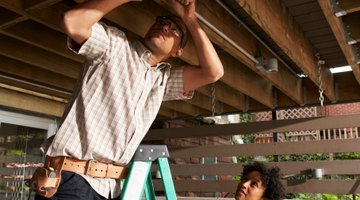How to Lay Out High Hat Lights
Providing adequate and effective lighting in a room is an important part of planning the layout of lights. High hat lights provide a relatively easy-to-calculate area of illumination and are an attractive fixture that is not obtrusive to your room design.

Things You Will Need
- Room diagram
- Ceiling height measurement
Planning how many lights and where to place them depends on the usage of the room, areas you desire ambient or functional lighting, as well as the height of your ceilings. Taking into account the variables and planning ahead are all part of making good a layout for your high hat light fixtures.
-
Determine the main uses for the room your high hat lights are being placed. In a kitchen for instance, certain areas require more concentrated light for detail work, while others are better served by ambient light that is more comfortable. A living room may have focal areas such as a fireplace or sitting area, or you may desire a uniform lighting plan for the entire space. Take into consideration the main uses for the room, what you will do there and which parts of the room you will use the most.
-
Measure the height of the ceilings if you don't already know how high they are. The height of the ceiling in relation to the beam of light the high hats cast will help you determine the number of lights you need and the distance they will be placed. The normal beam angle in a room with an 8-foot ceiling, using a an R 40 standard flood bulb is 9 feet, with the highest concentration of light in the central 5 feet of the beam. A table is available from Forteelectric.com in the resource section to help determine your beam width.
-
Decide if any of the lights will be angled to focus on a particular object or space, such as a fireplace, large painting or sitting area placed in a corner. These lights will not necessarily add much to the overall room lighting so you need to take into consideration this type of light focus if you wish to use it, and add those to your plan.
-
Sketch a layout of the placement of your lights based on the beam width you have determined is applicable to your ceiling height. Show the area that each individual high hat will illuminate and note on the sketch special considerations such as kitchen counters. High hats need to be placed closer together to cover this type of area with concentrated lighting, as opposed to a general dining area where you would want more diffused and comfortable light. Move the high hat placements accordingly to provide the coverage that suits the needs of your room and its use. Use these sketches to confer with your electrical contractor and order the number of lights based on your layout.
Writer Bio
Caprice Castano recently left the field of construction management to operate her own contracting business and spend time developing her writing career. Current projects include freelance writing for Internet publications and working on novel-length fiction.
Photo Credits
- Chris Clinton/Lifesize/Getty Images
- Chris Clinton/Lifesize/Getty Images
More Articles



